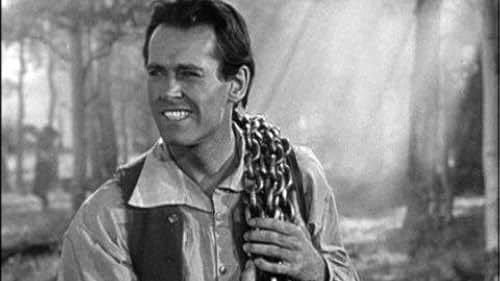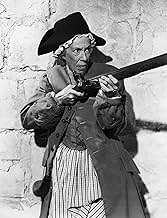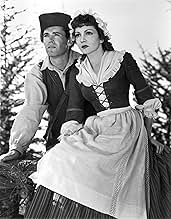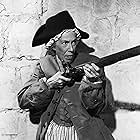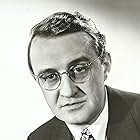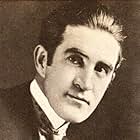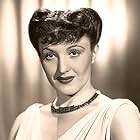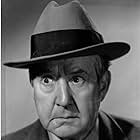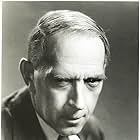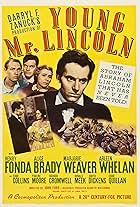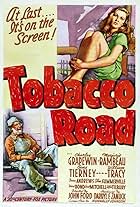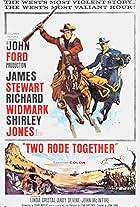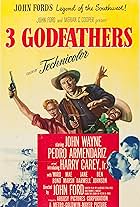IMDb RATING
7.0/10
6.9K
YOUR RATING
Newlyweds Gil and Lana Martin try to establish a farm in the Mohawk Valley but are menaced by Indians and Tories as the Revolutionary War begins.Newlyweds Gil and Lana Martin try to establish a farm in the Mohawk Valley but are menaced by Indians and Tories as the Revolutionary War begins.Newlyweds Gil and Lana Martin try to establish a farm in the Mohawk Valley but are menaced by Indians and Tories as the Revolutionary War begins.
- Nominated for 1 Oscar
- 1 nomination total
Jack Pennick
- Amos Hartman
- (as J. Ronald Pennick)
Storyline
Did you know
- TriviaThe battle so vividly described by Gil Martin (Henry Fonda) is the bloody Battle of Oriskany, which had one of the highest casualty rates of any battle in the war. It took place on August 6, 1777, and involved only North American troops--Tory, Patriot and Indian--and was part of what became the overall Battle of Saratoga, as the Tory and Indian troops were commanded by a subordinate of Gen. "Gentleman Johnny" Burgoyne. Gen. Nicholas Herkimer, who was wounded in the battle, did not receive adequate medical attention. His leg became infected and he died ten days later from blood loss after amputation on August 16. He was 49. Despite Gil's claim that the colonials gave them a "licking," the Tories and Indians suffered only 150 casualties while the Patriots sustained 450.
- GoofsThe real William Caldwell was not killed in the Mohawk Valley assault on the fort as suggested by the film, but lived to fight on the British side during the War of 1812.
- Quotes
Reverend Rosenkrantz: Any man failing to report to duty will be promptly hanged. Amen.
- Crazy creditsOpening credits prologue: 1776 AT THE BORST HOME IN ALBANY, NEW YORK
- ConnectionsEdited into March on, America! (1942)
- SoundtracksCountry Gardens
(uncredited)
Traditional 18th Century dance
Arranged by Edward B. Powell and Conrad Salinger
Featured review
When Lana Martin (Claudette Colbert) arrives by wagon with her new husband, Gil (Henry Fonda), to Mohawk Valley and his homestead, she isn't prepared for what she sees. The time is just before the Revolutionary War. The valley is beautiful and unspoiled, but the homestead is a one-room log cabin Gil has built, and the farm will need to be worked by the two of them. Lana has never seen an Indian, but in the course of the movie she's going to see a lot, and most won't be friendly.
Drums Along the Mohawk is John Ford's curious but effective look at one aspect of the Revolutionary War. The story isn't about George Washington or the great battles. It's the story of what happens in this one, isolated valley in upstate New York. While there are Indian attacks and we can see the results of a battle or two, the story really is about Lana Martin and how she changed. We watch her and Gil build their farm, and we see it burnt to the ground when war comes to the valley. From a young woman in a big, frilly dress facing a life she had never imagined, by the end of the movie Lana is wearing a soldier's coat and is prepared to shoot down an attacker, which she does with hardly a blink. She sees Gil return from his first battle almost shell-shocked. We see her and Gil having to become hired hands when their farm is destroyed. We see her suffer a miscarriage. At the start of the movie, Gil was an honest, hard-working young man, almost naive at times. Now he and Lana are watching the birth of their new nation. They've both become...capable. "Well," Gil says to her at the close, "I reckon we'd better be getting' back to work. There's going' to be a heap to do from now on." And we know he's talking about building a nation, not just a new farm.
The movie is effective despite John Ford's long-time propensity for ham-handed humor, sentimental myth building and his indulgence in stereotypical portrayals of Indians as either child-like objects of amusement or animal-like objects of fear. What saves this story, as it saved many of Ford's films, is his great talent for cinematic story-telling. As corn-ball as some of the scenes in this movie are -- the short, chubby drunk or Gil's amazement that his wife is giving birth or the wise but child-like behavior of the Christian Indian chief -- we still are caught up in Gil's and Lana's story. Although the movie is particularly a paean to the women who had to struggle on, sometimes fighting, sometimes waiting, Ford gives the film an unusual unwarlike tone. The widow Mrs. McKennar, who took Gil and Lana in when their farm was destroyed, looks at Gil marching off to his first battle and thinks about her husband. "Sometimes he'd wave. Ten to one he wasn't even seeing me. He was thinking about all those men, you see. All those men he went out to fight...to kill and be killed...blast his eyes, loving it." One powerful scene has Gil and the other men back from the battle. They won but it didn't go well. Gil has collapsed, and as Lana tends to him he barely notices her. He just stares into the distance while he tells what happened when they were ambushed. "I got down back of a log and aimed at a fellow. He leaped straight up in the air. Fell forward on his face. After that we just kept shooting as fast as we could load for I don't know how long. Adam Hartman came over beside me. His musket was broke. He had a spear. He kept grinning. I remember thinking, 'He's having a good time. He likes this.' Pretty soon he pointed off. I saw an Indian coming toward us, naked. I tried to load but it was too late. Adam stood up and braced his spear and the Indian came down. I never saw a fellow look so funny, so surprised. He just hung there, with his mouth open...lookin' at us, not sayin' a word. I had to shoot him, there wasn't anything else to do."
Ford pushes the buttons of duty, faith and patriotism. We've learned that war isn't the glorious struggle some make it out to be. Still, Ford shows us that fighting to protect our land, to protect our chance to build our farm and keep our children safe is proper. In 1939, that was a strong message. So was his theme of patriotism with which he closes the movie. At the fort in Mohawk Valley a company of regular soldiers arrives to tell the people that the war has been won, that Cornwallis has surrendered to Washington. They're carrying a flag. A churchman looks at it and says to the others, "So that's our new flag, the thing we've been fighting for. Thirteen stripes for the colonies and thirteen stars in a circle for the Union." And with that a couple of men take the flag and climb to the top of the church steeple, where they tie it down so that it waves in the wind. Ford knew how to punch home a point, alright.
Fonda and Colbert were both fine actors. Fonda, in particular, brings, as usual, a strong sense of decency to his role. While I think he and Colbert make a slightly improbable pair (Colbert in all her roles, for me, seems to have a sly worldliness that makes her so good at sophisticated comedy), they work well together. The movie is really war from a woman's point of view, and Colbert brings it off.
Drums Along the Mohawk is John Ford's curious but effective look at one aspect of the Revolutionary War. The story isn't about George Washington or the great battles. It's the story of what happens in this one, isolated valley in upstate New York. While there are Indian attacks and we can see the results of a battle or two, the story really is about Lana Martin and how she changed. We watch her and Gil build their farm, and we see it burnt to the ground when war comes to the valley. From a young woman in a big, frilly dress facing a life she had never imagined, by the end of the movie Lana is wearing a soldier's coat and is prepared to shoot down an attacker, which she does with hardly a blink. She sees Gil return from his first battle almost shell-shocked. We see her and Gil having to become hired hands when their farm is destroyed. We see her suffer a miscarriage. At the start of the movie, Gil was an honest, hard-working young man, almost naive at times. Now he and Lana are watching the birth of their new nation. They've both become...capable. "Well," Gil says to her at the close, "I reckon we'd better be getting' back to work. There's going' to be a heap to do from now on." And we know he's talking about building a nation, not just a new farm.
The movie is effective despite John Ford's long-time propensity for ham-handed humor, sentimental myth building and his indulgence in stereotypical portrayals of Indians as either child-like objects of amusement or animal-like objects of fear. What saves this story, as it saved many of Ford's films, is his great talent for cinematic story-telling. As corn-ball as some of the scenes in this movie are -- the short, chubby drunk or Gil's amazement that his wife is giving birth or the wise but child-like behavior of the Christian Indian chief -- we still are caught up in Gil's and Lana's story. Although the movie is particularly a paean to the women who had to struggle on, sometimes fighting, sometimes waiting, Ford gives the film an unusual unwarlike tone. The widow Mrs. McKennar, who took Gil and Lana in when their farm was destroyed, looks at Gil marching off to his first battle and thinks about her husband. "Sometimes he'd wave. Ten to one he wasn't even seeing me. He was thinking about all those men, you see. All those men he went out to fight...to kill and be killed...blast his eyes, loving it." One powerful scene has Gil and the other men back from the battle. They won but it didn't go well. Gil has collapsed, and as Lana tends to him he barely notices her. He just stares into the distance while he tells what happened when they were ambushed. "I got down back of a log and aimed at a fellow. He leaped straight up in the air. Fell forward on his face. After that we just kept shooting as fast as we could load for I don't know how long. Adam Hartman came over beside me. His musket was broke. He had a spear. He kept grinning. I remember thinking, 'He's having a good time. He likes this.' Pretty soon he pointed off. I saw an Indian coming toward us, naked. I tried to load but it was too late. Adam stood up and braced his spear and the Indian came down. I never saw a fellow look so funny, so surprised. He just hung there, with his mouth open...lookin' at us, not sayin' a word. I had to shoot him, there wasn't anything else to do."
Ford pushes the buttons of duty, faith and patriotism. We've learned that war isn't the glorious struggle some make it out to be. Still, Ford shows us that fighting to protect our land, to protect our chance to build our farm and keep our children safe is proper. In 1939, that was a strong message. So was his theme of patriotism with which he closes the movie. At the fort in Mohawk Valley a company of regular soldiers arrives to tell the people that the war has been won, that Cornwallis has surrendered to Washington. They're carrying a flag. A churchman looks at it and says to the others, "So that's our new flag, the thing we've been fighting for. Thirteen stripes for the colonies and thirteen stars in a circle for the Union." And with that a couple of men take the flag and climb to the top of the church steeple, where they tie it down so that it waves in the wind. Ford knew how to punch home a point, alright.
Fonda and Colbert were both fine actors. Fonda, in particular, brings, as usual, a strong sense of decency to his role. While I think he and Colbert make a slightly improbable pair (Colbert in all her roles, for me, seems to have a sly worldliness that makes her so good at sophisticated comedy), they work well together. The movie is really war from a woman's point of view, and Colbert brings it off.
- How long is Drums Along the Mohawk?Powered by Alexa
Details
- Release date
- Country of origin
- Language
- Also known as
- Darryl F. Zanuck's Production of Drums Along the Mohawk
- Filming locations
- Production company
- See more company credits at IMDbPro
Box office
- Budget
- $2,000,000 (estimated)
- Gross worldwide
- $10,360
- Runtime1 hour 44 minutes
- Color
- Aspect ratio
- 1.37 : 1
Contribute to this page
Suggest an edit or add missing content

Top Gap
By what name was Drums Along the Mohawk (1939) officially released in India in English?
Answer
